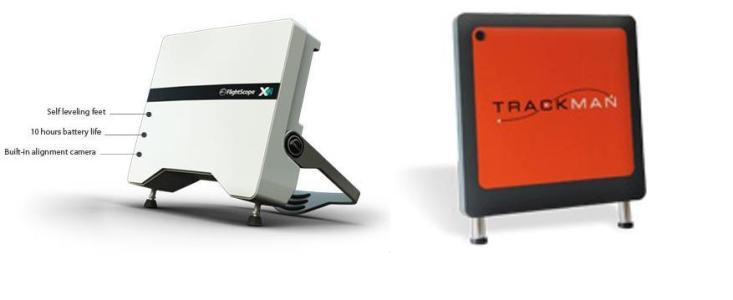Titolo: TrackMan III con TPS video o Flightscope X2i complete ?
Autore: Piero Maina
Conteggio parole: 1430
Dilemma, quale comprare? Possiedo già due launch monitor della Golftek che oltretutto nel mese di luglio 2011 ha pensato bene di fallire. Possiedo il Pro III e relativo applicativo software e il Pro 7. Sono due ottimi prodotti per uso indoor che utilizzano entrambi la tecnologia dei sensori infrarossi e richiedono quindi una lampada spot al di sopra del tee per effettuare le misurazioni. Peccato perchè la Golftek era sul mercato da 34 anni e i suoi prodotti erano fra i più affidabili e precisi e questo era dimostrato da test effettuati con i robots. Certo questa tecnologia necessitava di un uso indoor o perlomeno la base di partenza doveva essere necessariamente indoor. Il Pro 7 che è stato l’ultimo Launch monitor prodotto da parte di Golftek, aveva ben 86 sensori e procedeva alla misurazione reale di 5 parametri del volo della palla e 7 caratteristiche dello swing. Ripeto che questi dati erano misurati e non calcolati come fanno la maggior parte dei prodotti in commercio.
Non è mia volontà in questo articolo fare nomi di figli e figliastri, né dire che questo prodotto non funziona, ma voglio solo dire che oggi sul mercato gli unici due prodotti che utilizzano la tecnologia radar in maniera affidabile e che sono realmente un gradino sopra gli altri, sono il Flightscope X2 e il TrackMan III. Anzi va detto che fino all’anno scorso, l’unico,il solo,il vero era il TrackMan II e nessun altro prodotto poteva venire comparato, certamente il prezzo era proibitivo, ma le caratteristiche del prodotto e i dati fruibili che venivano erogati giustificavano in parte il costo di € 20.000,00 + IVA. Inoltre fino a quattro anni fa il TrackMan era utilizzabile solo per uso outdoor, mentre ora è utilizzabile sia indoor che outdoor. Il prodotto è identico, ma c’è una limitazione nel software utilizzato nell’uso indoor, anche perchè il volo della palla e gli altri parametri sono misurati nei primi 3,5 mt. del volo della palla e il resto è frutto di complessi algoritmi che si basano sull’enorme database di colpi giocati in possesso di TrackMan, misurati dal software per uso outdoor. Comunque le ore per utilizzo outdoor, nel caso uno voglia usare il prodotto sporadicamente all’esterno, sono acquistabili separatamente e poi eventualmente dedotte (al 50% del costo), nel caso uno volesse passare dal modello indoor a quello outdoor in maniera definitiva. Quanto costa il modello outdoor? Tanto! Certo bisogna vedere se aggiungere il quasi indispensabile software TPS (TrackMan Performance Studio) e bisogna tenere conto di altri accessori e forme di garanzia che faranno lievitare il prezzo che è ad oggi di € 18.495,00 + IVA al 25%. Si avete letto bene, il paese che emette fattura è la Danimarca e lì la VAT si paga al 25%. Siamo a più di € 24.000, aggiungendo custodia, set up,etc. Il modello indoor è comunque vicino ai € 20.000 IVA compresa (€15.000 IVA esclusa). Stiamo quindi parlando di investimenti importanti, soprattutto per un maestro di golf che voglia utilizzare queste tecnologie per fare lezione e dare quindi valore aggiunto alla sua professionalità e credetemi molti maestri nel mondo utilizzano il TrackMan e dovreste vedere di cosa è capace questo strumento. Lo stesso vale per il giocatore professionista che voglia analizzare le sue sessioni di pratica (oltre 70 top players nel mondo hanno acquistato il TrackMan, fra loro Ian Poulter, Darren Clarke, Martin Kaymer, Edoardo Molinari e molti altri). Le più grandi case produttrici di attrezzatura golfistica hanno acquistato il TrackMan (Callaway,Ping,Titleist,etc.) e pure Royal&Ancient e USGA (I due governing bodies) e in ultimo molti clubfitter che come me necessitano di uno strumento affidabile e preciso per l’analisi dello swing e del volo della palla per poter creare la giusta attrezzatura senza dover fare invalide assunzioni. Certo, ma cifre come quelle riportate sopra per un piccolo imprenditore o per un privato, come e in quanto tempo si ammortizzano? Verrebbe da rispondere mai, ma va da se che in tutti i casi ci vogliono diversi anni. Il R.O.I. qui non mi sembra molto azzeccato,come direbbe l’on. Di Pietro. C’è solo la certezza di possedere uno strumento che ci fornirà dati importanti,precisi,affidabili e quindi a patto di saperne fare buon uso, dati fruibili.
Veniamo ora al confronto, fino alla metà dello scorso anno non esisteva, in quanto Flightscope produceva a suo dire prodotti analoghi al TrackMan (Flightscope kudu), ma il volo della palla non era interamente misurato ed inoltre lo stesso software non era paragonabile, né la calibrazione o il set-up del prodotto erano semplici come il TrackMan. Tant’è che come ho scritto sopra, le case,i giocatori di torneo e tutto il mondo golfistico che contava utilizzava il TrackMan. E’ vero che Flightscope costava e costa molto meno, ma per chi con i dati ci lavora, se questi non sono affidabili e quindi non fruibili,il risparmio non sussiste, anzi è meglio non avere feedback che avere informazioni sbagliate. Ma dall’anno scorso, la Flightscope ha immesso sul mercato il modello x2i che oltre ad essere accattivante esteticamente, ha caratteristiche davvero interessanti, è utilizzabile sia indoor che outdoor (allo stesso costo), ha la connessione WiFi e quindi è utilizzabile con l’Ipad e altri tablets oltre che con i classici laptops, ha la durata della batteria di 10 ore e tanto altro ancora, ma quello che più interessa è che chi ha potuto testarlo e metterlo in comparazione con il TrackMan III ha ottenuto risultati analoghi per un costo decisamente inferiore. (€ 11.000 circa + IVA al 20%) Il confronto può essere visionato qui.
Quindi, come detto sopra, questo primo articolo non vuole essere di confronto fra i due prodotti, ma mettervi al corrente che sto procedendo all’acquisto di uno dei due, il mio cuore è sempre stato sul TrackMan, ma è anche vero che prima i paragoni non esistevano, oggi troviamo “forse” molto per poco, visto che i dati sono molto simili,ma la differenza di prezzo è enorme. Cosa c’è di così diverso da giustificare tutta questa differenza? Questa è la domanda che si pongono in molti fra gli addetti ai lavori. Non so se è perchè il Flightscope non sia ancora stato testato estensivamente, ma ad oggi Il mondo golfistico che conta continua a rimanere fedele a TrackMan anche se si cominciano a vedere nomi e istituzioni anche nel mondo di Flightscope.
Io prenderò la mia decisione nelle prossime settimane e avrò l’occasione di provare le due macchine prima di decidere. Vi comunicherò la mia scelta non appena sarà stata fatta. Stay tuned!
Update al 16 Marzo 2012: Sono passati quasi due mesi da quando ho scritto questo articolo e non avete avuto più notizie. Semplicemente perchè avevo appuntamento per la prova del Flightscope dopo il 19 febbraio u.s. con il responsabile Europeo, ma non ci siamo incontrati, visto che mi racconta che dopo il PGA Show di Orlando le vendite del Flightscope sono decollate sensibilmente, pertanto è abbastanza impegnato da non riuscire a muoversi e mi ha comunicato che ad oggi il tempo di attesa per l’X2i dopo l’ordine è di circa 5 settimane destinato a salire se ci sarà un ulteriore incremento degli ordini. Siamo comunque riusciti ad organizzare un appuntamento con una persona che possiede l’X2i nella mia zona e potrò finalmente testarlo il 28 Marzo p.v. Con TrackMan ero rimasto che avrei visionato il TMIII dopo la prova con l’X2i e poi avrei deciso. Al momento non sono pressato e sono convinto che dovranno esserci livellamenti di prezzo che sono fisologici quando non si opera più in regime di monopolio e la qualità dei prodotti diventa simile. So che c’è una nuova release del software per Flightscope in arrivo a breve e mi attendo da TrackMan altre novità a breve, come è logico che accada nel mondo della tecnologia. E’ tutto.
Update al 28 Marzo 2012: Come avevo annunciato ho avuto l’opportunità di vedere il Flightscope X2 all’opera indoor. Purtroppo il primo test non è andato a buon fine, forse per il fatto che abbiamo testato il Golftek e il Flightscope insieme ed essendo il Golftek allineato nel raggio visivo del Flightscope, il primo abbia influenzato le letture del secondo. Oppure lo spazio a disposizione si è rivelato insufficiente, nonostante mi era stato detto il contrario. Avevo 2,10 mt. di spazio dietro la palla e 4,40 mt. di spazio davanti alla palla al fine di registrarne il volo. I dati elaborati dal FS non erano sicuramente fruibili ed infatti il Golftek ha fornito dati per quella situazione decisamente più veritieri. Prossimamente testerò il FS nuovamente nella stessa situazione con ulteriori accorgimenti e in più aggiungeremo il CG2 della Foresight al test,al fine di avere un ulteriore termine di paragone.
Stay tuned!
TrackMan III con TPS video o Flightscope X2i complete ? – Update –
© Copyright 2012 – 2023 Piero Maina – Tutti i diritti riservati





